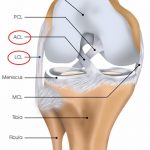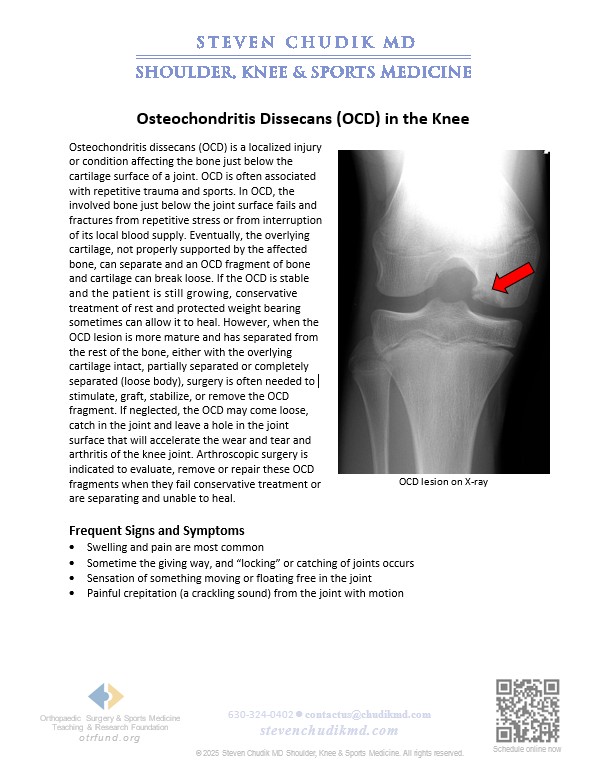 New functional capacity evaluation for ACL injuries definitely tests likeliness for re-injury and readiness to return to sport
New functional capacity evaluation for ACL injuries definitely tests likeliness for re-injury and readiness to return to sport
Osteochondritis dissecans (OCD) is a localized injury or condition affecting the bone just below the cartilage surface of a joint. OCD is often associated with repetitive trauma and sports. In OCD, the involved bone just below the joint surface fails and fractures from repetitive stress or from interruption of its local blood supply. Eventually, the overlying cartilage, not properly supported by the affected bone, can separate and an OCD fragment of bone and cartilage can break loose. If the OCD is stable (not loose) and the patient is still growing, conservative treatment of rest and protected weight bearing sometimes can allow it to heal. However, when the OCD lesion is more mature and has separated from the rest of the bone, either with the overlying cartilage intact, partially separated or completely separated (loose body), surgery is often needed to stimulate, graft, stabilize, or remove the OCD fragment. If neglected, the OCD may come loose, catch in the joint, (causing pain, locking, clicking, etc.) and leave a hole in the joint surface that will accelerate the wear and tear and arthritis of the knee joint. Arthroscopic surgery is indicated to evaluate, remove or repair these OCD fragments when they fail conservative treatment or are separating and unable to heal.
Small, stable OCDs may not cause problems and may not be symptomatic. The larger more mature or loose OCD fragments are more of a problem because they can be difficult to heal. These lesions typically cause swelling, pain, and functional limitations. It is possible for these injuries to compromise the joint surface and lead to symptomatic arthritis over time. Appropriate treatment can improve symptoms (swelling, pain, functional limitations), maintain the joint surface, and allow return to activity.
Depending on the size, location, age of patient, and severity of the OCD lesion, treatment options may vary. If the patient is young and the OCD lesion appears stable, conservative treatment is often the first choice. Conservative treatment generally consists of decreased weight bearing and activity modification to allow the underlying bone time to healing. Following this period of rest, the patient is often referred to a physical therapist or athletic trainer to gradually load the bone and restore strength and range-of-motion before returning to activities. Restriction of activities, particularly sports, may be required for more than six months in some cases.
For persistent symptoms (swelling, pain, functional limitations) despite conservative treatment, larger and more mature lesions, loose fragments within the joint, or symptomatic cartilage injury identified on MRI, surgery to restore the function of the damaged joint surface is usually recommended. Some OCDs can be repaired while others cannot, depending on the size, location, age, etc. of the lesion. In either situation, Dr. Chudik evaluates and treats OCDs through small limited arthroscopic incisions and specialized instruments of his own design. Lesions that cannot be repaired can be removed with special instruments and the hole left in the bone and cartilage can be smoothed of any rough or loose edges and stimulated to fill in with reparative tissue. Other OCD lesions can be repaired in a variety of ways depending on the location and size of the OCD lesion. Dr. Chudik will discuss various options with you and help determine the best treatment for you.
Learn More